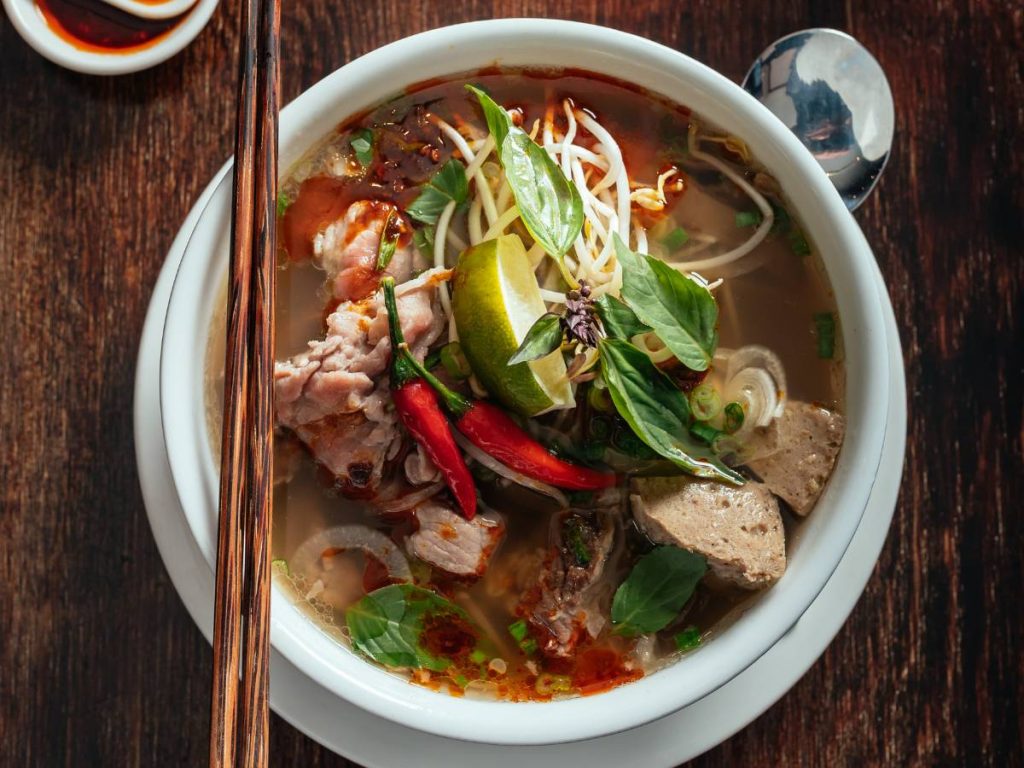Pho is a distinctive and beloved dish, often considered the soul and essence of Vietnam. When it comes to Vietnamese cuisine, it is certain that the first dish that comes to mind for many foreigners is Pho. So, what are Top 5 things you may not know about Pho? Let’s explore them through the following article compiled by Pho Maniac.
5 interesting facts about Pho
Did you know: Pho has its origins from the French language. The original and beloved Pho dish is not Pho Hanoi. The distinctive flavors of Pho vary by region (Northern and Southern Vietnam). Enjoying Pho in the proper way involves using chopsticks and condiments. The broth of Pho is an art itself, and a delicious bowl of Pho owes its excellence to the flavorful broth.

1. Pronunciation and Origins of Pho
Pho, with its unique pronunciation as “fuh,” can be quite a mouthful for non-Vietnamese speakers. However, this iconic dish’s origins and cultural significance make it worth mastering the correct pronunciation. Pho traces its roots back to Northern Vietnam, particularly in the bustling city of Hanoi, where it has been a cherished culinary tradition for well over a hundred years.
Interestingly, the name “Pho” has its origins in French cuisine. During the French colonial period in Vietnam, the French introduced their classic beef stew known as “pot-au-feu.” Vietnamese locals adapted and transformed this French dish, incorporating their own culinary techniques and flavors to create what we now know as Pho.
The evolution of Pho reflects the vibrant cultural exchange that occurred between Vietnam and France, resulting in a dish that combines Vietnamese ingenuity with French culinary influences. Today, Pho has transcended borders and has become a beloved symbol of Vietnamese cuisine, admired for its complex flavors, comforting qualities, and historical significance.
2. The Art of Broth you may not know about Pho
The art of crafting Pho’s signature broth is truly a labor of love. It is a process that requires time, patience, and skill. The broth is made by simmering high-quality beef or chicken bones for several hours, allowing the flavors to develop and intensify.
The key to a rich and flavorful Pho broth lies in the selection and preparation of the ingredients. Charred onions and ginger add depth and a subtle smoky note to the broth, while cinnamon and star anise contribute warm and fragrant undertones. Additionally, a medley of secret herbs and spices, carefully chosen by each Pho chef, enhances the complexity of the broth, giving it a distinct character.
Throughout the simmering process, the broth undergoes constant skimming to remove impurities, ensuring a clear and clean final result. This meticulous attention to detail is what sets apart a truly exceptional Pho broth from the rest.
The end result is a broth that exudes a heavenly aroma and boasts a harmonious blend of savory, sweet, and aromatic flavors. It is the foundation upon which the entire Pho experience is built. When combined with the accompanying rice noodles, tender slices of meat, and an array of fresh herbs, bean sprouts, and lime wedges, the broth brings all the components together, creating a symphony of tastes and textures.
The art of crafting Pho broth is a time-honored tradition that has been passed down through generations. It reflects the dedication and passion of Vietnamese chefs who strive to deliver the most authentic and delightful Pho experience to their patrons. Each bowl of Pho tells a story, encapsulating the culinary heritage and soul of Vietnam, making it a truly remarkable dish enjoyed by people all around the world.
3. Regional Variations
Pho, the iconic Vietnamese noodle soup, not only holds a special place in the hearts of Vietnamese people but also offers regional variations that highlight the diversity of flavors and culinary traditions across different parts of the country. The two most prominent variations are Pho Bac, representing the Northern style, and Pho Nam, representing the Southern style.
Pho Bac features a clear broth, thin rice noodles, and simpler garnishes, while Pho Nam showcases a slightly sweeter and more complex broth with various herbs, bean sprouts, and lime served on the side.
4. The Art of Condiments
When served, Pho is accompanied by a plate of fresh herbs, lime wedges, bean sprouts, and various condiments. These condiments, including hoisin sauce, Sriracha, and fish sauce, allow diners to customize their Pho according to their preferred taste.
Experimenting with different combinations can enhance the overall flavor profile and create a personalized dining experience.
5. Pho Culture and Etiquette
Pho, beyond its culinary significance, holds a special place in Vietnamese culture and social gatherings. It serves as more than just a delicious meal; it symbolizes unity and togetherness. Sharing a bowl of Pho with friends and family is a cherished tradition that brings people closer and fosters a sense of community.
When it comes to enjoying Pho, there are certain cultural practices and etiquettes that add to the overall experience. First and foremost, using chopsticks to handle the noodles and herbs is the customary way of enjoying Pho. The chopsticks allow for greater control and precision when picking up the delicate rice noodles and fresh herbs that adorn the bowl. It is also common to use the chopsticks to add additional condiments, such as chili sauce or hoisin sauce, to personalize the flavor of the Pho according to individual preferences.
So, the next time you indulge in a bowl of Pho, remember to embrace the chopsticks, savor the broth with a spoon, and feel free to slurp your noodles with enthusiasm. Immerse yourself in the Pho culture and enjoy the unique and heartwarming experience it offers.
Conclusion
Pho is not just a dish; it encapsulates culture and history within it. Hopefully, the article has provided you with useful information about Pho. So, the next time you savor a bowl of Pho, remember the fascinating facts behind this beloved Vietnamese dish.

